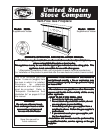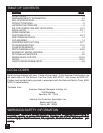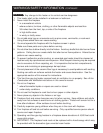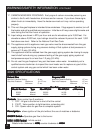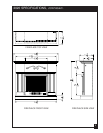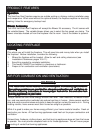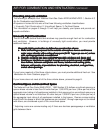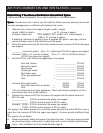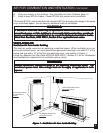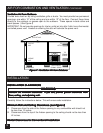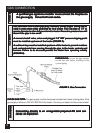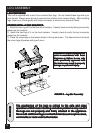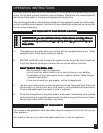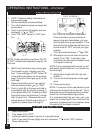
AIR FOR COMBUSTION AND VENTILATION
CONTINUED
Providing adequate ventilationProviding adequate ventilation
Providing adequate ventilationProviding adequate ventilation
Providing adequate ventilation
The following is excerpts from
National Fuel Gas Code. NFPA 54/ANSI Z223.1, Section 5.3,
Air for Combustion and Ventilation.
All spaces in homes fall into one of the three following ventilation classifications:
1. Unusually Tight Construction; 2. Unconfined Space; 3. Confined Space.
The information on pages 6 through 10 will help you classify your space and provide ad-
equate ventilation.
UnUn
UnUn
Un
usuallusuall
usuallusuall
usuall
y y
y y
y
Tight ConstructionTight Construction
Tight ConstructionTight Construction
Tight Construction
The air that leaks around doors and windows may provide enough fresh air for combustion
and ventilation. However, in buildings of unusually tight construction, you must provide
additional fresh air.
Unusually tight construction is defined as construction where:Unusually tight construction is defined as construction where:
Unusually tight construction is defined as construction where:Unusually tight construction is defined as construction where:
Unusually tight construction is defined as construction where:
a.a.
a.a.
a.
WW
WW
W
alls and ceilings ealls and ceilings e
alls and ceilings ealls and ceilings e
alls and ceilings e
xposed to the outside atmosphere haxposed to the outside atmosphere ha
xposed to the outside atmosphere haxposed to the outside atmosphere ha
xposed to the outside atmosphere ha
ve a continve a contin
ve a continve a contin
ve a contin
uousuous
uousuous
uous
water vapor retarder with a rating of one perm (6x10 kg per pa-sec-m ) or lesswater vapor retarder with a rating of one perm (6x10 kg per pa-sec-m ) or less
water vapor retarder with a rating of one perm (6x10 kg per pa-sec-m ) or lesswater vapor retarder with a rating of one perm (6x10 kg per pa-sec-m ) or less
water vapor retarder with a rating of one perm (6x10 kg per pa-sec-m ) or less
with openings gasketed or sealed with openings gasketed or sealed
with openings gasketed or sealed with openings gasketed or sealed
with openings gasketed or sealed
andand
andand
and
b.b.
b.b.
b.
WW
WW
W
eather stripping has been adeather stripping has been ad
eather stripping has been adeather stripping has been ad
eather stripping has been ad
ded on openabded on openab
ded on openabded on openab
ded on openab
le windole windo
le windole windo
le windo
ws and doorws and door
ws and doorws and door
ws and door
s s
s s
s
andand
andand
and
c.c.
c.c.
c.
Caulking or sealants are applied to areas such as joints around window andCaulking or sealants are applied to areas such as joints around window and
Caulking or sealants are applied to areas such as joints around window andCaulking or sealants are applied to areas such as joints around window and
Caulking or sealants are applied to areas such as joints around window and
door frames, between sole plates and floors, between wall-ceiling joints,door frames, between sole plates and floors, between wall-ceiling joints,
door frames, between sole plates and floors, between wall-ceiling joints,door frames, between sole plates and floors, between wall-ceiling joints,
door frames, between sole plates and floors, between wall-ceiling joints,
between wall panels, at penetrations for plumbing, electrical, and gas lines,between wall panels, at penetrations for plumbing, electrical, and gas lines,
between wall panels, at penetrations for plumbing, electrical, and gas lines,between wall panels, at penetrations for plumbing, electrical, and gas lines,
between wall panels, at penetrations for plumbing, electrical, and gas lines,
and at other openings.and at other openings.
and at other openings.and at other openings.
and at other openings.
If your home meets all of the three criteria above, you must provide additional fresh air. See
Ventilation Air From Outdoors
, page 10.
If your home does not meet all of the three criteria above, proceed to page 8.
Confined Space and Unconfined SpaceConfined Space and Unconfined Space
Confined Space and Unconfined SpaceConfined Space and Unconfined Space
Confined Space and Unconfined Space
The National Fuel Gas Code (ANSI Z223.1, 1992 Section 5.3) defines a confined space as a
space whose volume is less than 50 cubic feet per 1,000 BTU per hour (4.8m per kw) of the
aggregate input rating of all appliances installed in that space and an unconfined space as a
space whose volume is not less than 50 cubic feet per 1,000 BTU per hour (4.8m per kw) of
the aggregate input rating of all appliances installed in that space. Rooms communicating
directly with the space in which the appliances are installed*, through openings not furnished
with doors, are considered a part of the unconfined space.
* Adjoining rooms are communicating only if there are doorless passageways or ventilation
grills between them.
3
3
7
-11 2



